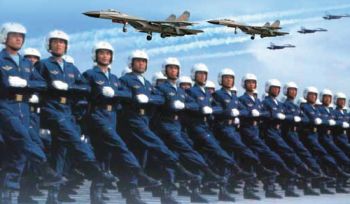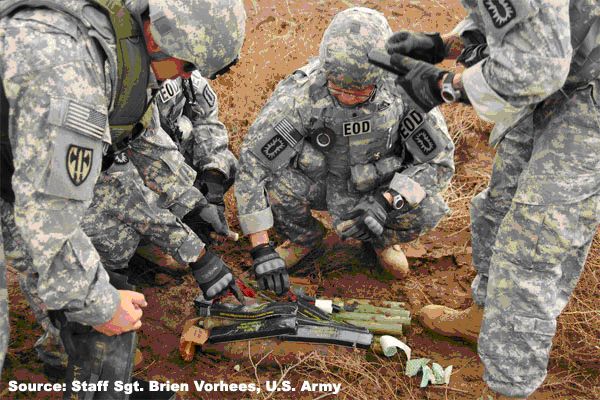Since the 1990s, China has paid close attention to developments in airpower thought in other countries. In formulating its own offensive-defensive doctrine, the PLAAF has synthesised US assessments of the Gulf War, Kosovo campaign and US operations in Afghanistan and Iraq, building on the doctrine that it has practiced since the days of Russian assistance and influence. There is recognition of the air force as a major national capability to contain and win wars, yielding a significant PLAAF role in strategic deterrence and a desire for the capability to win high-tech local wars with airpower. Former President Jiang Zemin asserted that “we must construct a powerful people’s air force ‘with Chinese characteristics,’ that is both offensive and defensive.“5
 |
Operationally, the PLAAF is going to aim to extend its reach and its lethality in order to enable the joint operational concepts — the — greater PLA is adopting as it thinks through how to fight and win high tech 21st century wars
As part of this drive China plans to accelerate PLAAF modernisation, transform it from a homeland air defence type of air force to a type that combines both offense and defence and develop modernised capabilities to defend China’s security and interests. In 2004, in accord with the Central Military Commission’s new military strategy programme, the PLAAF formalised this approach in a new air force strategy (actually more operational doctrine than strategy), which integrated air and space, with both attack and defence.
The PLAAF is a multifaceted service with many missions; therefore, it already has a strategy. As we saw beginning in 1992 the PLA established a committee of NDU and PLAAF officers to initiate research on Air Force strategy, culminating in the publication of Science of Air Force Strategy in 1995. This book laid out an argument, based on international air power doctrine, for the PLAAF to be an “independent” service and to be assigned its own operational component in the PLA’s National Military Strategic Guidelines.
PLAAF strategy
The Gulf War and the 1995- 96 Taiwan Strait crisis provided additional ammunition for the PLAAF to seek its own strategic doctrine. For example, statements by Former Chinese Communist Party (CCP) Central Military Commission (CMC) Chairman Jiang Zemin and recently installed PLAAF commander Liu Shunyao emphasised the PLAAF’s requirement to fight offensive battles. In 1997, General Liu stressed this new strategic direction in the following words:
“The Chinese Air Force plans to build-up state-of-the-art weapon systems by early next century, including early warning aircraft, electronic warfare warplanes and surface-to-air missiles. The PLA Air Force is now able to fight both defensive and offensive battles under high-tech conditions. The Air Force is now capable of waging high level long distance combat, rapid manoeuvrability and air defence and is able to provide assistance to Navy and ground forces. Over the next few years, the Chinese Air Force will enhance its deterrent force in the air, its ability to impose air blockades and its ability to launch air strikes, as well as its ability to conduct joint operations with the ground forces and Navy”.
The CMC approval
In 2004, the CMC approved the PLAAF’s “Active Defence” strategy as a component of the National Military Strategic Guidelines for air operations. The PLAAF’s strategic component was designated as “Integrated Air and Space, Simultaneous Offensive and Defensive Operations.” The approval also signalled a fundamental shift in how the PLAAF was to be viewed.
The article states that this change is encapsulated in three bold new assertions on the strategic positioning of the PLAAF:
- First, the PLAAF is a national Air Force led by the CCP.
- Second, a modern Air Force must be built to unify aviation and spaceflight, combine defence and offense and unify information and firepower.
- Third, the PLAAF should be a strategic Air Force standing side by side with the Army and Navy to achieve command of the air, ground and sea.
New warfare concepts
At the strategic level of discourse, the PLAAF today is beginning to rethink the roles and missions it must assume and the capabilities it must have, to conduct aerospace operations that will achieve Beijing’s larger national objectives. Exactly what is meant when the PLAAF is exhorted to become a “strategic air force” is still unfolding. What is clear at this point is that the PLAAF is no longer viewed as being solely a tactical adjunct to ground force operations or a service mainly concerned with territorial air defence. It is evident that the leadership of the PLA is looking to the PLAAF to be capable in the future of offensive operations in larger joint campaigns and even to “execute long range precision strikes and strategic projection operations” although at the moment, these latter two missions are challenging. In 2004, in recognition of the new emphasis the PLA leadership places on the aerospace dimensions of warfare, the PLAAF was finally given its own service-level strategy, known as “Integrated Air and Space, Being Prepared for Simultaneous Offensive and Defensive Operations.”
Joint experience
Another noteworthy trend in the past few years is the assignment of PLA Air Force general officers to important national level military assignments. The PLA has traditionally been dominated by “army green” and, to a certain extent, it still is. However, more blue uniforms (PLAAF) are showing up in venues that matter reflecting more jointness in the make-up of its national level leadership relative to the past.6
For example:
- Since 2004, the commander of the PLAAF (along with the commander of the PLA Navy and Second Artillery) has been a member of the Military Commission of the Central Committee of the Chinese Communist Party (CMC), the national command authority for the PRC.
- In 2003, PLAAF Lieutenant General Zheng Shenxia became the first air force officer appointed as head of the prestigious PLA Academy of Military Science (AMS). The AMS serves as a think tank directly subordinate to the CMC and both drives and executes major initiatives of PLA-wide reform and modernisation in the realms of military strategy, the operational art and tactics.
- In 2006, PLAAF Lieutenant General Ma Xiaotian became the first air force officer appointed as Commandant of the PLA National Defence University (NDU). In 2007, Ma became one of the four Deputy Chiefs of the General Staff with the important portfolio of intelligence and foreign affairs for the entire PLA.
- In the last few years, PLAAF general officers have also been appointed to various Deputy Director positions in the General Political Department (GPD) and General Logistics Department (GLD).
- Moreover, since the early 1990s, the practice of concurrently dual hatting each Military Region Air Force commander as a Military Region deputy commander has been institutionalised.
Conclusion
It is clear that the PLAAF is going to become more operationally capable over time. That said, its transition from a primarily tactical asset to a “strategic air force” will not happen overnight or without problems along the way; there are weighty systemic and technological challenges that will guarantee a certain amount of friction.
What one can state with some certainty is the following:
- The fundamental decisions the CMC makes for the entire PLA will continue to shape the major contours of future PLAAF reform and modernisation programmes administratively and operationally. Therefore, any understanding of where the PLAAF will be in 5 to 10 years must factor in the bigger picture of where the PLA will be and why.
- Bureaucratically, because of historical precedents and how the Chinese defence establishment continues to be organised and managed, the PLAAF is unlikely to develop the very unique service persona or accrue the same degree of independence that characterise the services in other major powers. That said, if the PLAAF links its institutional stature in the PLA system to where its general officers are placed at the national level, then the PLAAF is going to continue to accrue bureaucratic gravitas over time.
- Operationally, the PLAAF is going to aim to extend its reach and its lethality. PLA is adopting as it thinks through how to fight and win high-tech 21st century wars. Regardless of the shortcomings it may exhibit today, the vector clearly points towards enhanced range and capabilities.
- The PLAAF has the potential to be an air force, among other regional air forces, that will shape the future operational environment in the Asia-Pacific region and, perhaps one day, even beyond.
Finally, although the PLAAF has traditionally emphasised defensive operations, that is no longer the case and the PLAAF will be an aggressive opponent in the event of a conflict. The PLA clearly prefers to achieve air superiority by attacking its enemy on the ground or water. Especially at the beginning of a war, the PLA will endeavour to attack enemy air bases, ballistic missile bases, aircraft carriers and warships equipped with land-attack cruise missiles before enemy aircraft can take off or enemy missiles can be launched. These attacks, moreover, will be carried out not by China’s air force operating in isolation but in coordination with the Second Artillery’s conventional ballistic and cruise missiles.
The PLA Air Force is now able to fight both defensive and offensive battles under high-tech conditions. The Air Force is now capable of waging high level long distance combat, rapid manoeuvrability and air defence and is able to provide assistance to Navy and ground forces. Over the next few years, the Chinese Air Force will enhance its deterrent force in the air, its ability to impose air blockades and its ability to launch air strikes, as well as its ability to conduct joint operations with the ground forces and Navy
——————————-
5 Guo Jinxiao, “The Science of Air Force Strategy,” Chinese Military Encyclopedia (Beijing: Military Science Publishing House, 2002), 311–312.
6 Yang Xiaobo et al., Science of Joint Campaign Command (Beijing: Military Science Publishing House, December 2005), 282.
About the Author:
Gp Capt J V Singh (retd)
The writer was commissioned as an Officer in Indian Air Force in 1978. He is a graduate of Defence Services Staff College and in addition has undergone a diploma course at National Institute of Industrial Engineering (NITIE) during his service tenure. He has also worked as a Senior Fellow with Centre for Air Power Studies while he was in active service for a period of two years. He has recently retired from Indian Air Force and he has rejoined as a senior fellow at the Centre once again. His current research project relates to the understanding of China’s Aerospace Strategy and its present status and future implications for the Asia Pacific Region as well as its larger role as a global player.
Defence and Security Alert (DSA)
Defence and Security Alert (DSA) magazine is the only ISO 9001:2008 certified, premier world class, new wave monthly magazine which features paradigm changing in-depth analyses on defence, security, safety and surveillance, focusing on developing and strategic future scenarios in India and around the world.

 von
von 

